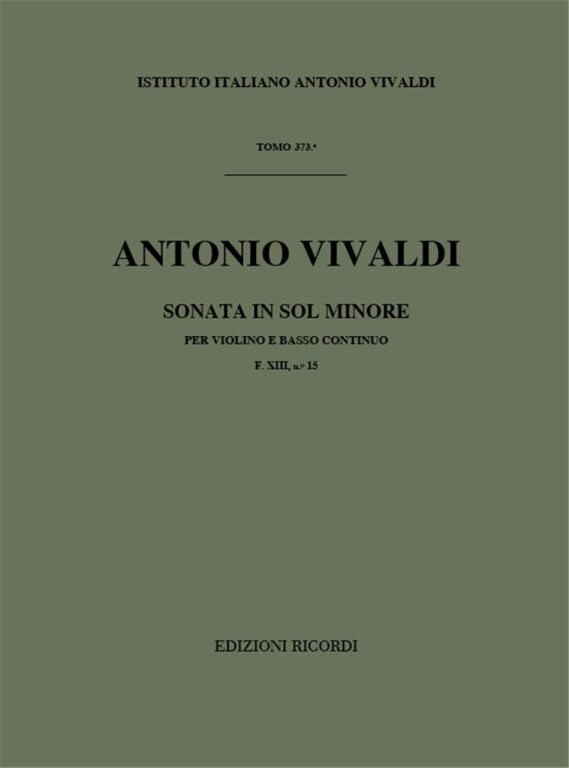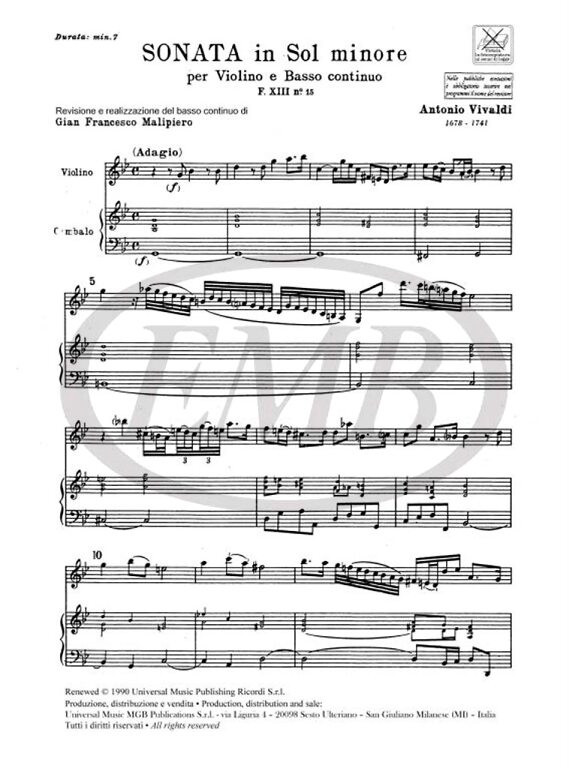Description
Antonio Vivaldi: Sonata for Violin and Basso Continuo in G Minor, RV 26
Product Information
- ISMN: 9790041910239 / 979-0041910239
- Product Type: Sheet Music
- Setting: Violin and Basso Continuo
- Period: Baroque
- Weight: 0.062 kg
- Published: 1984
- Publisher: Ricordi
- Item Number: PR00102300
- Other Reference: PR 1023
Overview
The "Sonata for Violin and Basso Continuo in G Minor, RV 26" is a captivating chamber work by Antonio Vivaldi, exemplifying the elegance, drama, and expressive depth of the Baroque sonata da chiesa (church sonata) style. Composed likely in the early 18th century, this sonata reflects Vivaldi’s skill at writing music that blends technical brilliance with lyrical nuance, particularly for his own instrument—the violin. Written for solo violin and basso continuo, the sonata is typically structured in four contrasting movements (often in a slow-fast-slow-fast sequence). The opening movement sets an expressive, often solemn tone, followed by more rhythmically vigorous sections that showcase virtuosic figuration, rapid scales, and dynamic contrasts. The slow movements are marked by lyrical, cantabile lines, giving the performer opportunities for expressive interpretation and ornamentation.
The basso continuo—usually played by harpsichord and cello or bass viol—provides harmonic support and rhythmic structure while engaging in a subtle dialogue with the solo violin. Vivaldi’s mastery in writing for the violin is evident throughout the piece, with inventive melodic turns, sequences, and expressive chromaticism adding emotional depth. This sonata not only demonstrates Vivaldi’s deep understanding of the violin’s expressive range, but also his ability to convey dramatic contrasts and affective states within the intimate format of chamber music. The G minor key adds a somber, introspective character, lending the work an emotional gravitas typical of many of Vivaldi’s minor key compositions. RV 26 remains a fine example of Italian Baroque violin sonatas—rich in expression, structural clarity, and technical brilliance—and continues to be performed today by violinists seeking both virtuosity and depth in their repertoire.
Italian Translation - Overview
La "Sonata per Violino e Basso Continuo in Sol Minore, RV 26" è una raffinata composizione da camera di Antonio Vivaldi, che incarna l’eleganza, il dramma e la profondità espressiva dello stile della sonata da chiesa barocca. Composta probabilmente nei primi decenni del XVIII secolo, questa sonata riflette l’abilità di Vivaldi nello scrivere musica che unisce brillantezza tecnica e sensibilità lirica, in particolare per il violino, il suo strumento d’elezione. Scritta per violino solista e basso continuo, la sonata è solitamente articolata in quattro movimenti contrastanti, spesso alternando tempi lenti e veloci (largo–allegro–largo–allegro). Il movimento iniziale introduce un’atmosfera espressiva e spesso austera, mentre i movimenti veloci presentano passaggi virtuosistici, scale rapide e contrasti dinamici. I movimenti lenti, invece, sono caratterizzati da linee melodiche cantabili e profonde, che offrono all’interprete spazio per l’ornamentazione e l’espressività.
Il basso continuo, generalmente affidato al clavicembalo e al violoncello o alla viola da gamba, fornisce una solida base armonica e ritmica, ma partecipa anche al dialogo musicale con il violino, contribuendo alla tessitura sonora complessiva. La maestria di Vivaldi nella scrittura per violino si manifesta in ogni battuta, grazie a linee melodiche inventive, sequenze eleganti e cromatismi espressivi. Questa sonata dimostra non solo la profonda conoscenza di Vivaldi delle possibilità espressive del violino, ma anche la sua capacità di trasmettere contrasti drammatici e stati d’animo intensi attraverso la forma intima della musica da camera. La tonalità di Sol minore conferisce all’opera un carattere malinconico e riflessivo, tipico delle composizioni più introspettive del compositore. La RV 26 rimane un esempio eccellente della sonata barocca italiana per violino, apprezzata per la sua espressività, chiarezza formale e brillantezza tecnica, e continua a essere eseguita oggi da violinisti che cercano profondità e virtuosismo nel repertorio solistico.
Product Features
- Format: Score
- Dimensions: Standard A4
- Instrumentation: Violin and Basso Continuo
- Period: Baroque, showcasing Vivaldi's distinctive compositional style
- Length: 24 pages
Interesting Facts
- Expressive Range: The sonata is known for its emotional depth and the beautiful interplay between the violin and the continuo.
- Historical Context: This work is part of Vivaldi's extensive output for string instruments, reflecting his innovative approach to instrumental music.
- Cultural Significance: RV 26 is an important piece in the violin repertoire, demonstrating Vivaldi's skill in writing for string instruments.
Italian Translation - Interesting Facts
- Gamma Espressiva: La sonata è nota per la sua profondità emotiva e il bellissimo dialogo tra il violino e il continuo.
- Contesto Storico: Quest’opera fa parte dell’ampia produzione di Vivaldi per strumenti ad arco, riflettendo il suo approccio innovativo alla musica strumentale.
- Significato Culturale: L’RV 26 è un pezzo importante del repertorio violinistico, che dimostra l’abilità di Vivaldi nella scrittura per strumenti ad arco.
Publishers
Published by Ricordi in 1984. All rights reserved under item number PR00102300 and ISMN 9790041910239 / 979-0041910239.
We value your feedback! Share your experience with this product to help others make informed decisions. Your review is important to us!
Hashtags
English:
#Vivaldi #ViolinSonata #BaroqueMusic #ClassicalSheetMusic #Ricordi #MusicalMasterpiece
















